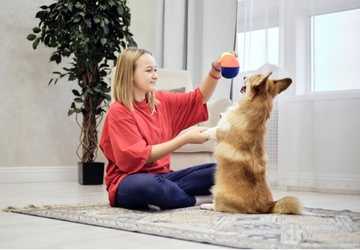Bringing a new furball into a home bustling with other pets can be as tricky as juggling flaming torches. But fear not because, with a dash of patience and a sprinkle of strategy, you can make the introduction smoother than a cat's nap. Here are down-to-earth tips to help you ace the art of introducing a new pet to your multi-pet family.

Like grandma's secret stew recipe, introducing a new pet is about taking it slow. Imagine if someone barged into your favorite hangout spot, tossing confetti and shouting, "I'm here!" You'd probably raise an eyebrow or two, right? Pets are no different.
Start by letting your new buddy get familiar with one room. Allow them to soak in the smells and vibes of their new kingdom. Meanwhile, give your existing pets a chance to sniff around the newcomer's scent, subtly weaving them into the introduction dance.
Once the initial scent exchange is done, open the door to a supervised face-to-face meeting. Keep it brief, like a coffee break, and watch for body language. You're on the right track if tails are wagging and whiskers aren't bristling.
Imagine if your neighbor suddenly decided to picnic in your living room – it'd be weird, right? The same goes for pets. Introducing them in a neutral territory is like hosting a meetup at a mutual friend's house – it's less awkward and reduces territorial tension.
Take your new pet and resident furballs to a neutral space, like a nearby park or a friend's yard. This levels the playing field, allowing everyone to feel on equal ground. Remember, the key is to make the first meeting less about territory disputes and more about camaraderie.
Let them sniff and snoop around together. Keep it light, like a Sunday afternoon stroll. If things start getting heated, have a distraction ready – a favorite toy or a pocketful of treats. Positive associations will turn potential standoffs into friendly, nose-to-nose encounters.
Imagine brokering world peace with a bag of potato chips. Well, when it comes to pet introductions, treats are your secret weapon. Treat diplomacy works like a charm, turning potential rivals into snack-sharing pals.
During the initial encounters, keep a stash of treats handy. Each time your pets exhibit positive behavior – a wagging tail, a friendly sniff – reward them. It's like a pat on the back for good behavior, building positive associations with the new addition.
Remember, fairness is key. Treat all your pets equally to avoid any jealousy or rivalry. You want them to associate the new pet with positive experiences and delicious rewards, turning the introduction process into a series of yummy reunions.
Even the most extroverted pets need some "me time." Introducing a new pet into a multi-pet household can be overwhelming, so ensure each furry friend has their own sanctuary space.
Set up cozy spots where your pets can retreat when they need a break – a comfy bed, a quiet corner, or even a designated room. This provides a haven for your pets to recharge and escape the hustle and bustle of socializing.
Ensure each pet knows where their sanctuary space is and that it's off-limits to others. It's their oasis, free from the new pet's curious nose or the relentless pursuit of playtime. This way, everyone can have their haven, ensuring a harmonious coexistence.

As you wouldn't dive into a potluck without knowing who cooked what, pets appreciate a sneak peek into each other's scent repertoire before the grand introduction, swap bedding or toys between your new pet and the resident one. This olfactory exchange lets everyone get acquainted with each other's unique aroma, making the first face-to-face encounter less of a surprise party.
Place the exchanged items in their respective spaces so that the scents can become woven into the fabric of each pet's territory. This prelude helps ease the transition by making the new pet's arrival feel more like a reunion with a familiar friend than an invasion by a stranger.
Remember the first day at a new school when you bonded with classmates over shared activities? Well, pets aren't much different. Organize group activities to create positive associations and team spirit among your furry bunch.
Engage them in activities like a joint play session or a shared grooming time. This communal experience fosters a sense of unity and shared enjoyment. Positive interactions during these activities help build bonds and dissipate any lingering tension, making your pets view each other as potential playmates rather than rivals.
Keep the activities short and sweet, ensuring they end on a high note. This way, each pet associates the group activities with positive experiences, paving the way for a more amicable coexistence.
Just like humans, pets have their personalities and comfort zones. Some may be social butterflies, while others prefer the quiet comfort of solitude. Respecting these individual differences is crucial for a harmonious multi-pet household.
Observe each pet's body language and reactions during interactions. If one pet seems stressed or overwhelmed, give them space. Some pets may need more time to adjust, and forcing them into social situations can backfire. Understand and respect their boundaries, letting them set the pace for social integration.
Additionally, be mindful of any signs of stress, such as excessive hiding, changes in eating habits, or aggressive behavior. If you notice any concerning signs, consult a vet or a professional pet behaviorist to address potential issues and tailor your introduction plan accordingly.
Pets thrive on routine, and introducing a new member to the family can disrupt their sense of order. To ease the transition, maintain a consistent daily routine for feeding, playtime, and rest. Predictability provides a sense of security for your pets, helping them adjust to the changes more smoothly.
Consistency extends to the rules and expectations you set for all pets. Reinforce positive behavior with rewards and gently correct undesirable actions. This uniform approach establishes a fair and predictable environment, reducing potential conflicts and fostering a sense of fairness among your pets.
Introducing a new pet into a multi-pet household is like orchestrating a symphony – it requires patience, careful planning, and a touch of finesse. By taking it slow, using neutral territory, employing treat diplomacy, and providing sanctuary spaces, you'll pave the way for a harmonious pet ensemble that even Beethoven would applaud. So, gear up, maestro, and let the pet-friendly symphony begin!